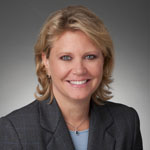Hala Moddelmog, the president of Arby’s Restaurant Group, Inc., feels like she’s grown up with the Arby’s brand. Since her first job out of graduate school, Moddelmog’s devotion to roast beef’s effigy has led her down an interesting career path, from Arby’s to Church’s Chicken to Susan G. Komen and back again to Arby’s, a professional mixture that has amplified her success as one of the most inspirational leaders of our time.
When Moddelmog joined the Atlanta-based quick-service sandwich company as president, her first challenge was to revitalize a brand that was suffering from a financial crisis after a $4.3 million profit loss—a contention that many would avoid, but Moddelmog was up for the challenge.
From day one, Moddelmog has aggressively turned around the company, from menu development to a new building and logo design to a revitalized leadership team. She has launched new ad campaigns, sold 93 Arby’s units in refranchising deals, refined the customer’s in-store experience—all by putting the right team in place to get the job done, and done well. Sales have increased significantly since; in April, the company began reporting nine consecutive quarters of same-store sales increases. In sum, Moddelmog gave the company a complete A-to-Z face-lift.
Hala’s Mission
Timeline of the Arby’s Revamp
MAY 2010
Moddelmog joins Arby’s as president. She is hired to revitalize the brand and its products after four years of profit losses, as well as to revitalize the Arby’s Foundation.
JANUARY 2011
Moddelmog reenergizes the existing leadership team and brings in new talent to support her vision.
JULY 2011
Arby’s is sold from the Wendy’s/Arby’s Group Inc. and is acquired by Roark Capital Group.
SEPTEMBER 2011
Arby’s begins working to support Share Our Strength’s No Kid Hungry campaign, an initiative to end childhood hunger in America.
OCTOBER 2011
To conduct extensive research into the company’s target market, surveys are sent to 6,000 quick-service consumers. They provide valuable data to better understand opportunities within the marketplace.
MARCH 2012
Moddelmog organizes a team to conduct an ethnographic study of Arby’s key market, establishing the trends of loyal Arby’s users. It is one of many marketing efforts that have contributed to nine consecutive quarters of same-store sales growth.
OCTOBER 2012
Arby’s repositions its brand with a logo redesign, the launch of a new advertising campaign, and amped-up product development—effectively reintroducing the company to the public.
NOVEMBER 2012
Moddelmog quadruples Arby’s
product-development pipeline, offering fresh, new menu options.
PRESENT
Remodeled restaurants are being tested in three markets, establishing a modern dining experience that better meets the needs of the modern Arby’s consumer.
Moddelmog’s sights didn’t end there. Arby’s philanthropic wing, the Arby’s Found-ation, has existed for 25 years. Its initial mission was to help children through Big Brothers Big Sisters of America. While Moddelmog saw this as an admirable partner, her marketing instincts told her that the organization wasn’t fully aligned with the Arby’s brand.
Moddelmog and Arby’s began working with Share Our Strength’s No Kid Hungry campaign, an initiative that brings awareness to childhood food insecurity, which is often overlooked. Moddelmog saw this as an opportunity in which Arby’s and its foundation could lead to a boost in consumer awareness and nationwide understanding. Moreover, food insecurity—the feeling of not knowing where the next meal will come from—has increased since the recession hit nationwide five years ago.
“When we are raising a society with 16 million children who are food insecure, who don’t feel as healthy and can’t focus in school, they’re not going to be able to reach their full potential,” Moddelmog says. “The nation will become less secure and less productive, which affects all of us.”
The No Kid Hungry network—which is comprised of community members, local food banks, government agencies, and other nonprofits—has set up
summer-meal sites where children up to the age of 18 years old can receive free meals during the summer. Sites are USDA-registered and are safely held in schools, churches, and community centers.
In Georgia, which Moddelmog hopes will become a leading example for the country to follow, there are more than 1,000 summer-meal sites available. And there are tens of thousands of summer-meal sites open nationwide, according to the 2011 Food Research and Action Center report. Some feeding sites even offer hot evening meals for children with working parents.
The Arby’s Foundation, which has raised $5 million in two years, has been able to generate funds for its mission through an annual six-week pin-up program, the National Restaurant Fundraiser, wherein Arby’s restaurants across the country ask customers to donate a dollar to help end childhood hunger in exchange for a bounce-back coupon good for a future purchase. For each donation, customers may write their name on a card, which is displayed in the restaurant. The program not only raised more than $2.6 million on national, state, and local levels, but it also raised awareness of the issue in local communities.
To be successful in the modern marketing realm, you must get to know your customer; it guides everything you do. Some 18 percent of Arby’s customers represent 63 percent of the company’s sales. With this in mind, Moddelmog embarked on a brand journey to get an extensive understanding of Arby’s consumers. “If you get that deep understanding of your consumer, and are disciplined around designing everything around that target, you can really get a better connection with your consumer.”
The tried and true Arby’s users reside in the South and in the Midwest, known as the country’s “Beef Belt.” They like the truth, without fluff; they have robust patriotism and strong family values; and most importantly, they are interested in whether a product does what it says it’s going to do. Moddelmog put together a team that included an anthropologist, sociologist, and camera person to go inside about 60 homes in the Beef Belt region to conduct an ethnographic study and talk with people about the brand—an intensely enlightening technique that helped save the brand.
From freshly slicing meat daily in-store to using high-quality ingredients to giving back to the community by combating childhood hunger in a solution- and purpose-driven way, Arby’s has revitalized itself as the philanthropic food-service engine that Moddelmog knows it can and will be.
Knowing that hunger is a solvable issue, Moddelmog is 100 percent convinced that not only can the Arby’s brand be brought back to the greatness it deserves, but that childhood hunger in America can be solved through awareness, engagement, and access. The work has helped reinstate faith in the Arby’s brand, repositioning the iconic company amongst its competitors, all while helping solve a boding national issue.

